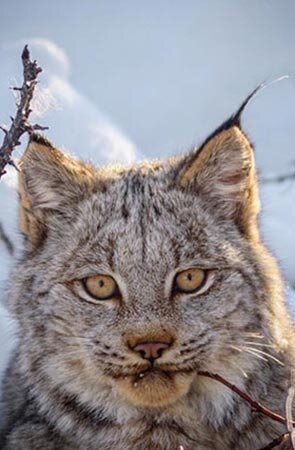Wildlife Wednesday Species Spotlight Program
While social distancing requires us to temporarily suspend our monthly Wildlife Wednesday seminars, that doesn’t mean the learning has to stop.
Enrich your wildlife knowledge by following along with our weekly Wildlife Wednesday Species Spotlight. Each week during the Covid-19 pandemic, we will highlight a new Alaskan species, provide fun and interesting facts about the species, and for a bit of destress time, an image of that animal to color (great for kids and adults alike!). Play along with our Trivia Tuesday on our Facebook page to get a hint on the week’s species. Tag Alaska Wildlife Alliance when you upload your outdoor photos of the species and/or your finished coloring sheet!
Lynx Fact Sheet
A female lynx near Glennallen. Researchers in Alaska and Canada are studying lynx, gaining insights into their movements and their dietary mainstay, snow shoe hares. Photo by Dash Feierabend, USFWS.
Scientific name
Lynx canadensis
General Description
The lynx is a large, short-tailed cat, similar to the bobcat, but distinguished by its long legs, furry feet, long tufts on the tip of each ear, and a black-tipped tail. Their large broad feet act as snowshoes to improve winter travel and hunting. They have dense soft fur that is buffy gray with indistinct spotting. Adult lynx typically weigh between 18 and 30 pounds, with males generally larger than females and sometimes weighing up to 40 pounds.
Range
Lynx are found over most of north America, although their numbers in the northern continental United States have been greatly reduced. Lynx in the contiguous U.S (Lower 48). were designated a distinct population segment (DPS) and were listed as threatened under the Endangered Species Act in 2000. Different from the Lower 48, lynx populations are present across mainland Alaska but are absent from the Aleutian Islands, Kodiak archipelago, the islands of the Bering Sea and some islands of Prince William Sound and Southeast Alaska. They inhabit much of Alaska’s forested terrain and use a variety of habitats, including spruce and hardwood forests, and both subalpine and successional communities. The best lynx habitat in Alaska occurs where fires or other factors create and maintain a mixture of vegetation types with an abundance of early successional growth, because this provides for the best habitat for their preferred prey. Lynx normally travel 1-5 miles per day with home ranges more than 100 square miles. The largest ranges occur when prey are scarce.
Wildlife biologist Mark Bertram and his team count on the curiosity of cats to live-trap lynx at the Yukon Flats National Wildlife Refuge just north of Fairbanks. They operate one of five study sites that span an enormous area of interior Alaska, hoping to learn more about the mysterious movements of an animal some have dubbed “the ghost cat.” “It’s really hard to know why they disperse,” Bertram says, “ We had one cat on the Yukon Flats that traveled west to east in nearly a straight line, covering 450 miles into Canada over two months. We have no idea why.” Read the full article, with stunning photos of lynx here.
Reproduction
Mating occurs in March and early April, and kittens are born about 63 days later under a natural shelter such as a spruce felled by wind, a rock ledge, or a log jam. Most litters contain two to four kittens, but sometimes as many as six are born and survive. At birth, lynx kittens resemble domestic cats and are buff colored with longitudinal (running head to tail) streaking on their backs. The kittens can open their eyes at about one month old and are weaned at about two to three months old. Kittens remain with their mother until late winter and acquire the hunting skills and knowledge necessary for their survival. During the following breeding season, family units begin to break up. The production and survival of lynx kittens is strongly influence by changes in prey availability. When prey are abundant, a high percentage of 1-year old or older female lynx produce kittens, most of which survive. When prey are scarce, very few yearling lynx breed, the number of breeding adults declines, and very few kittens survive until winter.
Diet
The primary prey of lynx in most areas is the snowshoe hare, but when hares are scarce lynx consume other small prey such as grouse, ptarmigan, squirrels, and microtine rodents. Lynx may also prey on caribou, Dall sheep, and foxes, especially during periods of snowshoe hare scarcity. Lynx travel and hunt at a walk most of the time and capture their prey with short bursts of speed. They often ambush hares and other small prey while bedded down near small game trails. Lynx are adept at climbing trees but hunt mainly on the ground, sometimes using tress as a refuge from larger predators, such as wolves.
An audio recorder in a lynx collar recorded continuous high quality audio, and this spectrogram graphically represents the audio. This shows a cat ambushing a hare. Courtesy Allyson Menzies.
Fun Facts
The lynx is the only cat native to Alaska.
Because lynx are shy and unobtrusive animals, many people think they are scarce.
Trends in lynx population numbers are strongly correlated with the cyclic trends in snowshoe hare numbers, but lag behind by 1-2 years.
Lynx, like most cats, are very curious. Trappers often dangle something shiny from trees (CD, aluminum foil, etc) to lure lynx towards a trap.
Lynx can survive up to 14.5 years in the wild.
Information obtained, in part, from Alaska Department of Fish and Game.





